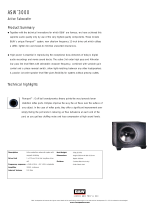These effects are related to the ratio of the sound
wavelength to the dimensions of the enclosure. The
resulting pressure and force gradients allowed the
reintroduction of bending forces on the walls of the
sphere, which raised the level of radiated sound and
coloration. Going back to our soap bubble analogy it
could be likened to the way a bubble flexes as it moves
through the air.
The obvious course to ameliorate this effect was to add a
second driver to power the enclosure from the opposite
end. Because of symmetry, this effectively halved the
volume loading each driver and doubled the frequency at
which these two effects began to cause a problem. The
second prototype, shown here, used two 380mm (15 in)
diameter drivers, one mounted at each end of a steel
marine floatation device. This prototype was capable of
producing prodigious levels of clean, articulate bass, but
was hardly a viable commercial proposition. Furthermore,
the resonances were still only just outside the effective
bandwidth of the device, due to its large dimensions.
However, the stage had been reached where a more
compact and visually appealing product could be
developed.
PV1 - Concept
The PV1, launched in June 2004, was developed directly
from this prototype. From a sphere that comfortably
passes through a basketball hoop, it creates truly
extended bass that defies its diminutive and gorgeous
exterior in both quality and quantity.
Although the Pressure Vessel concept was proven in very
large enclosure, it was obvious that its prime technical
merit of reducing cabinet stress was always going to find
a particular relevance with a smaller product. Indeed, the
PV1 represents a joyous meeting of minds for both
engineer and industrial designer.
The problems inherent to small subwoofers are often
compounded further by the industrial designer’s desire to
shave off centimetres here and there. The beauty of the
PV1 is precisely that its non-bending cabinet design
permits the use of a relatively thin aluminium shell,
maximising the internal volume and therefore minimising
the amount of equalisation required from the amplifier.
Early pressure vessel prototype















